Handling editor: Phanikrishna Thota
 |
|
Nonlinear and Complex Systems
Laboratory
Pohang University of Science & Technology in Pohang, Korea
by Seunghwan Kim
Department of Physics, POSTECH
|
The Nonlinear and Complex Systems Laboratory (NCSL)
was established in 1990 in the Department of Physics of the Pohang
University of Science & Technology in Pohang, Korea. Its goals are
to pursue interdisciplinary research on the basic understanding and
applications of nonlinear dynamics and complex systems. From the
1990s, NCSL has operated as one of the key centers of nonlinear
science in Korea with three professors and 20 PhD students, developing
the fundamental methodology of nonlinear dynamics, studying pattern
formation, self-organization, and chaos in nonlinear physical and
biological systems. Since July 1997, NCSL has participated in a
national research project on brain science as a key laboratory with a
focus on neurodynamics and information processing of the nervous
system. In June 2000, NCSL was selected as a National Research
Laboratory (NRL) by the Ministry of Science and Technology (MOST) in
Korea. The NCSL as an NRL has also been working on prediction of
complex time series based on chaos and complex system theory and
applications to biomedical and economic time series. The NCSL operates
as one of the key members of the Basic Science Research Institute and
the Brain Research Center at POSTECH and has been cooperating with
hospitals and research centers around Korea including Samsung Medical
School, Asan Medical Hospital, and Seoul National University
Hospital.
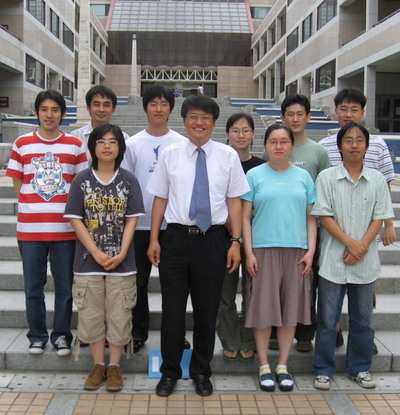 |
 |
 |
 |
|
NCSL group
photo; back row from left to right: Joonyoung Moon, Sungyun Kim,
Sunghoon Kim, Kyeyeon Hur, Hongseok Kim, Jeongkyu Shin; front row from
left to right: Eunjin Hwang, Seunghwan Kim, Jeongeun Hwang, Dongmyeong
Lee; insets from top to bottom: Myoung Won Cho, Gabjin Oh, and
Chang-Woo Shin.
|
The main current research interests of NCSL are the
development of the fundamental methodology of nonlinear dynamics and
the understanding of self-organization and pattern formation of
complex systems through modeling and analysis of biological complex
networks, neural networks of the brain, and economic systems. The key
mathematical techniques involve bifurcation theory, nonlinear time
series analysis, and computational modeling. The research projects of
our focus are:
Biophysics of neurons and neural networks
|
The brain is one of the
most challenging complex systems. The neurons, massively
inter-connected with each other, show highly complex and correlated
responses to external stimuli, which help the brain to extract
relevant patterns from sensory inputs, coordinate movements and
control behaviors. To understand the complexity of the nervous system
we need to characterize its network structure on which the
spatio-temporal firing activities are supported.
|
|
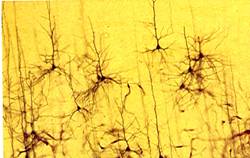 |
| The brain as a
complex network of neurons. |
|
Recent studies of
complex systems have shown that the synchronization of oscillators
including neuronal ones is faster, stronger, and more efficient in
small-world networks than in regular or random networks, and many
studies are based on the assumption that the brain may utilize the
small-world and scale-free network structure. Our study shows that the
functional structures in the brain are self-organized to both
small-world and scale-free networks by synaptic re-organization of the
spike timing dependent synaptic plasticity (STDP), which is hardly
achieved with conventional Hebbian learning rules. Here, the balance
between excitatory and inhibitory synaptic inputs is critical in the
formation of the functional structure, which is in a self-organized
critical state.
|
In the case of conventional Hebbian networks, all
synaptic connections between neurons increase under the common
external stimulus, whereas the others are weakened. However, the STDP
networks show that the neurons under common stimulus need not be fully
connected; only a small portion of the strengthened synapses forms a
sparse small-world scale-free network, which is dynamically more
effective and structurally more robust. This neural mechanism may be
utilized in modeling and controlling the neural networks more
efficiently. Furthermore, this work provides insight into the
formation of functional complex networks in the brain due to the
activity of dependent synaptic plasticity, and the developmental
processes of neural circuits, as in learning and memory models.
Functional self-organization in brain map development
How can we explain the different patterns in the
visual maps of mammals such as Macaque Monkey, cats, and tree shrews?
This highly ordered structure in the mammalian visual cortex has
attracted much attention from theoretical neurobiologists and has been
thoroughly studied with the expectation of providing the basis for
neural dynamics and computational models. The visual maps on the
cortex exhibit diverse ordered patterns, the most fundamental of which
is provided by the ocular dominance and orientation preference
columns. Though most of the models of the visual map formation are
based on common postulates such as Hebbian synapses, connections, or
competition between neighboring neurons and synaptic normalization,
there are quite a number of successful models with unique
mechanisms. The Hamiltonian models with spin variables are proposed
for the visual map formation that exhibit a striking analogy with the
physical systems such as magnetism.
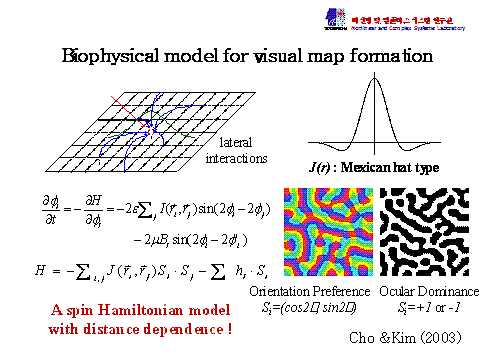 |
| Model of the visual map
formation. |
The characteristics of visual maps have been
systematically explored through the statistical properties of
`vortices' in magnetism. The spinlike Hamiltonian models represent
essential ingredients of neural interactions in the visual map
formation without paying much attention to particular neural control
mechanisms, and can be shown to exhibit common statistical properties
of the vortex formation as in other development models.
In animal experiments, the observed orientation
preference and ocular dominance columns in the visual cortex of the
brain shown various pattern types. We study the different visual map
formation in various mammals in the context of the crossover behavior
in anisotropic systems composed of orientational and scalar components
such as easy-plane Heisenberg models. The transition boundary between
different pattern types with anisotropy as a main bifurcation
parameter is predicted and shown to be consistent with the
classification of experimental observations for visual maps in Macaque
Monkey, cats, and tree shrews. This study shows a new possibility for
the study of the complex brain in the context of physical models.
Nonlinear analysis of biomedical time series
The biomedical time series is one of the paradigms
of complex time series. Biological systems continuously interact with
the environment and display complex dynamics. Measurements of
biological systems lead to complex time series that are nonstationary,
high dimensional, and noisy. We try to develop new nonlinear methods
for quantifying the nonlinear characteristics of biomedical time
series and apply these to the analysis of EEG and HRVs for the purpose
of diagnosis of epilepsy and other pathological brain states. In
particular, we have been working with the Samsung Medical School to
build the standardized database for the EEG research and developing
the seizure diagnosis and prediction system based on nonlinear
analysis algorithms.
 |
 |
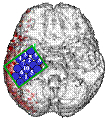 |
 |
| EEG analysis and
prediction system. |
The relationships between multichannel sites of the
electroencephalogram (EEG) have recently been one of the most
interesting subjects of research. To understand their complex and
dynamic relationships, various methods such as interdependence,
synchronization and information flow between multichannels have been
investigated. Epilepsy is a dynamics disease in which
self-organization and emergent structures occur dynamically at
multiple levels of neuronal integration. Therefore, the transient
relationship within multichannel EEGs is crucial for understanding
epileptic processes. We study the global relationship within
multichannel EEGs to gain more information on the classification of
different epilepsy types. The global network structure is determined
within channels of the scalp EEG based on the minimum spanning tree
method. The topological dissimilarity of the network structures from
different types of epilepsy is explored through the divergence rate
and applied to the data from patients, for example, with the left and
right temporal lobe epilepsy. We find that patients with different
epilepsy types exhibit different large-scale network structures, which
emerge at the epoch immediately before the seizure onset, not in the
preceeding epochs. This suggests that patients with two different
epilepsy types display distinct large-scale dynamics networks with
characteristic epileptic network structures.
Nonlinear analysis of economic time series
The economic time series is one of the most complex
time series, because it is strongly nonstationary and stochastic.
Recent market technology led to the accumulation of vast economic data
that can be utilized for nonlinear analysis. We propose an approach
for analyzing the basic relation between correlation properties of the
original signal and its magnitude signal by decomposing the original
signal into its positive and negative fluctuation components. We use
this relation for understanding the volatility correlation behavior,
where the original fluctuation signal is short-range correlated while
its magnitude signal is long-range correlated. We find that the
difference between the correlation properties of the original and its
magnitude signal is induced by the time organization structure of the
correlation function between fluctuation magnitudes of positive and
negative components. We show that this correlation function can be
described well by the stretched exponential function and is related to
the nonlinear property and the multifractal structure of the
signal.
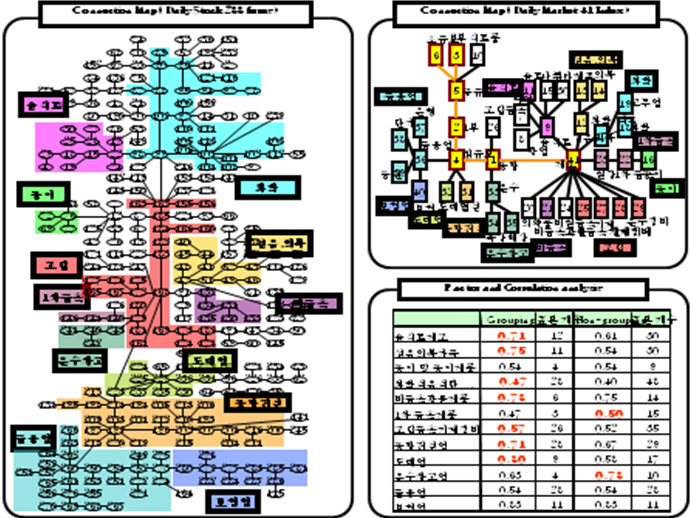 |
| Complex networks in the stock
and foreign exchange data. |
We also study the relative market efficiency in
diverse financial market data using the approximate entropy method for
the quantification of complexity, irregularity and unpredictability in
the time series. We used the global foreign exchange market indices
and found that on average the approximate entropy for typical mature
markets is higher than for typical emerging markets. In particular,
the market efficiency or the randomness of the time series diminishes
remarkably during a market crisis, for example, during the Asian
currency crisis. This study suggests that mature markets have a higher
market efficiency than emerging markets.
The NCSL also carries out the study of biophysical
models and numerical simulations of diverse biological systems in
cooperation with biological laboratories at POSTECH. These problems
include circadian rhythms, calcium dynamics in pancreatic cells, and
stomatal dynamics in plants. The important breakthroughs in science
come from unexplored territories in the interdisciplinary area,
leading to the emergence of a new paradigm. Our laboratory aims to go
beyond the barriers in the field of nonlinear and complex systems
through interdisciplinary cooperations with mathematicians,
physicists, biologists, biomedical scientists and economists.
Pohang is located at the Yongilman Bay area of the
East Sea and has a population of half million people. Pohang is well
known as an industrial city because of the Pohang Steel Company
(POSCO) and is now emerging as a science city after the establishment
of POSTECH in 1986, the Research Institute of Science and Technology
(RIST), the Pohang Accelerator Laboratory and the Synchrotron Light
Source, the Pohang Biotech Center, the Pohang Nanotechnology Center,
the Asia Pacific Center for Theoretical Physics, the Pohang Robotics
Center, and Techno Park. Applicants for the PhD program in the
nonlinear science group at the
Department of Physics
at POSTECH will be
nominated for an RA fellowship of the Brain Korea Program of the
Ministry of Education and Human Resources. Postdoctoral fellowships
are available every year and candidates are encouraged to apply to
both the Department of Physics at POSTECH and the
Asia Pacific Center
for Theoretical Physics
.
Selected publications since 1998:
| 1. |
Gabjin Oh, Cheoljun Eom,
and Seunghwan Kim, "Market efficiency in foreign exchange markets,"
Physica A 382, 209 (2007). |
| 2. |
Cheoljun Eom, Gabjin Oh,
and Seunghwan Kim, "Deterministic factors of stock networks based on
cross-correlation in financial market, Physica A 383,
139 (2007). |
| 3. |
Chang-Woo Shin and
Seunghwan Kim, "Self-organized criticality and scale-free properties
in emergent functional neural networks," Phys. Rev. E (Rapid
Comm.) 74, 045101 (2006). |
| 4. |
Woo Cheol Jun, Gabjin Oh,
and Seunghwan Kim, "Understanding the Volatility Correlation Behavior
with Magnitude Cross-correlation Function," Phys. Rev. E
73, 06628 (2006). |
| 5. |
Un Cheol Lee, Seunghwan
Kim, "Classification of epilepsy types through global network analysis
of scalp EEG," Phys. Rev. E 73, 041950 (2006). |
| 6. |
Myoung Won Cho and
Seunghwan Kim, "Different ocular dominance map formation influenced by
orientation preference columns in visual cortices,"
Phys. Rev. Lett. 94, 168701 (2005). |
| 7. |
Un Cheol Lee and
Seunghwan Kim, "Event and time-scale characteristics of heart-rate
dynamics," Phys. Rev. E 71, 061917 (2005). |
| 8. |
Myoung Won Cho and
Seunghwan Kim, "Understanding visual map formation through vortex
dynamics of spin Hamiltonian models," Phys. Rev. Lett.
92, 18101 (2004). |
| 9. |
Sang Wook Kim and
Seunghwan Kim, "Internal localized eigenmodes on spin discrete
breathers in antiferromagnetic chains with on-site easy-axis
anisotropy," Phys. Rev. B 66, 212408 (2002). |
| 10. |
Sunghwan Jung, Seunghwan
Kim and Byungnam Kahng, "Geometric fractal growth model for scale free
networks," Phys. Rev. E 65, 056101 (2002). |
| 11. |
Vladimir Astakhov,
A. Sabunin, W. Uhm and Seunghwan Kim, "Multistability formation and
synchronization loss in coupled Hénon maps: Two sides of the
single bifurcational mechanism," Phys. Rev. E 63, 056212
(2001). |
| 12. |
Sang Wook Kim and
Seunghwan Kim, "Fano resonances in translationally invariant
one-dimensional nonlinear chains," Phys. Rev. B 63,
212301 (2001). |
| 13. |
Sang Gui Lee and
Seunghwan Kim, "Parameter dependence of stochastic resonance in the
stochastic FitzHugh-Nagumo neuron," Phys. Rev. E 60, 826
(1999). |
| 14. |
Sang Gui Lee, Alexander
Neiman and Seunghwan Kim, "Coherence resonance in a Hodgkin-Huxley
neuron," Phys. Rev. E 57, 3292 (1998). |